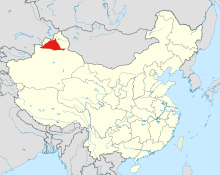
Back Džungarská pánev Czech ジュンガル盆地 Japanese 중가르 분지 Korean Kotlina Dżungarska Polish Džungárska panva Slovak جۇڭغار ئويمانلىقى UG 准噶尔盆地 Chinese 準噶爾盆地 ZH-YUE

The Junggar Basin (simplified Chinese: 准噶尔盆地; traditional Chinese: 準噶爾盆地), also known as the Dzungarian Basin or Zungarian Basin, is one of the largest sedimentary basins in Northwest China. It is located in Dzungaria in northern Xinjiang,[1] and enclosed by the Tarbagatai Mountains of Kazakhstan in the northwest, the Altai Mountains of Mongolia in the northeast, and the Heavenly Mountains (Tian Shan) in the south.[1][2] The geology of Junggar Basin mainly consists of sedimentary rocks underlain by igneous and metamorphic basement rocks.[3] The basement of the basin was largely formed during the development of the Pangea supercontinent during complex tectonic events from Precambrian to late Paleozoic time.[4] The basin developed as a series of foreland basins – in other words, basins developing immediately in front of growing mountain ranges – from Permian time to the Quaternary period.[1] The basin's preserved sedimentary records show that the climate during the Mesozoic era was marked by a transition from humid to arid conditions as monsoonal climatic effects waned.[2] The Junggar basin is rich in geological resources (e.g. petroleum, coal and ore deposits) due to effects of volcanism and sedimentary deposition.[3][5] According to Guinness World Records it is a land location remotest from open sea with great-circle distance of 2,648 km (1,645 miles) from the nearest open sea at 46°16′8″N 86°40′2″E / 46.26889°N 86.66722°E.[6]
- ^ a b c Bian, Weihua; Hornung, Jens; Liu, Zhenhua; Wang, Pujun; Hinderer, Matthias (2010-08-08). "Sedimentary and palaeoenvironmental evolution of the Junggar Basin, Xinjiang, Northwest China". Palaeobiodiversity and Palaeoenvironments. 90 (3): 175–186. Bibcode:2010PdPe...90..175B. doi:10.1007/s12549-010-0038-9. ISSN 1867-1594. S2CID 128870218.
- ^ a b Eberth, David A; Brinkman, Donald B; Chen, Pei-Ji; Yuan, Feng-Tian; Wu, Shao-Zu; Li, Gang; Cheng, Xian-Shen (2001). "Sequence stratigraphy, paleoclimate patterns, and vertebrate fossil preservation in Jurassic-Cretaceous strata of the Junggar Basin, Xinjiang Autonomous Region, People's Republic of China". Canadian Journal of Earth Sciences. 38 (12): 1627–1644. Bibcode:2001CaJES..38.1627E. doi:10.1139/e01-067. ISSN 0008-4077.
- ^ a b Lee, K.Y. (1985). "Geology of the petroleum and coal deposits in the Junggar (Zhungaer) Basin, Xinjiang Uygur Zizhiqu, Northwest China". Open-File Report. doi:10.3133/ofr85230. ISSN 2331-1258.
- ^ Cite error: The named reference
:10was invoked but never defined (see the help page). - ^ Cite error: The named reference
:5was invoked but never defined (see the help page). - ^ "Land farthest from sea". Guinness World Records. Retrieved 2023-02-27.